MARCH KEY FIGURES
 | Population at end Mar qtr 2004 | Change over previous year | Change over previous year |  |
| PRELIMINARY DATA | '000 | '000 | % |  |
|  |
| New South Wales(a) | 6,719.8 | 45.0 | 0.7 |  |
| Victoria | 4,962.0 | 59.7 | 1.2 |  |
| Queensland | 3,863.6 | 82.3 | 2.2 |  |
| South Australia | 1,533.2 | 8.4 | 0.6 |  |
| Western Australia | 1,975.8 | 32.0 | 1.6 |  |
| Tasmania | 481.7 | 5.4 | 1.1 |  |
| Northern Territory | 199.2 | 1.4 | 0.7 |  |
| Australian Capital Territory | 323.9 | 0.6 | 0.2 |  |
| Australia(b) | 20,061.8 | 234.8 | 1.2 |  |
|  |
| (a) March quarter 2004 births for New South Wales are low due to a lag in registration processing. This backlog has now been cleared and will be included in the June quarter 2004 estimates. |
| (b) Includes Other Territories comprising Jervis Bay Territory, Christmas Island and the Cocos (Keeling) Islands. |
Population growth

| Population growth rate, Year ended current quarter
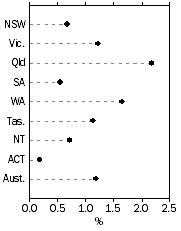
|
MARCH KEY POINTS
ESTIMATED RESIDENT POPULATION
- The preliminary estimated resident population (ERP) of Australia at March 2004 was 20,061,800 persons, an increase of 234,800 persons since March 2003 and 64,000 persons since December 2003.
- Natural increase during the March quarter 2004 was 26,300 persons.
- Preliminary net overseas migration was 37,600 persons in the March quarter 2004, a 9% decrease on the March quarter 2003.
POPULATION GROWTH RATES
- The Australian population grew 0.3% in the March quarter 2004 and 1.2% in the 12 months ended March 2004.
- For the year ended March 2004 all states and territories experienced positive population growth. Queensland recorded the highest growth rate (2.2%) and the Australian Capital Territory recorded the lowest (0.2%).
SPECIAL ARTICLE
- There were 54,000 divorces granted in Australia in 2002, representing a decrease of 2% (or 1,300 divorces) compared to divorces granted in 2001 (55,300).
- The median age of men at divorce was 42.2 years, up from 38.7 years in 1992. For women, the median age increased to 39.5 years, up from 35.9 in 1992.
NOTES
INTRODUCTION
Estimated resident population (ERP) data in this publication are based on the 2001 Census of Population and Housing (2001 census). Exceptions are tables 9, 17, 18 and 19 (excluding 2001 estimates), which are still based on the 1996 Census of Population and Housing (1996 census).
CHANGES IN THIS ISSUE
The layout and content of this publication has changed. The major changes are detailed below.
- A special article on Divorce in Australia has been included in this issue. This article includes previously unavailable divorces data for 2002.
- Tables 20 and 21 contain key indicators of national and state divorces and are included in this issue to accompany the special article.
- The Technical Note - Measuring Net Overseas Migration has been updated for March quarter 2004 and financial year 2002-03.
Revisions included in this issue are as follows:
- Data for household estimates for 2001 are now based on 2001 census data and are included in tables 17, 18 and 19.
- Natural increase, Net Overseas Migration and ERP for September quarter 2002 to June quarter 2003.
ERP DATA STATUS
At any point in time this publication contains final, revised and preliminary ERP data. The status of the ERP data included in this issue is as follows:-
- Final - All ERP data up to and including June quarter 2001
- Revised - ERP data from September quarter 2001 to June quarter 2003, inclusive
- Preliminary - ERP data from September quarter 2003 to March quarter 2004, inclusive.
NSW BIRTHS
March quarter 2004 births for New South Wales are low due to a lag in registration processing. This backlog has now been cleared and will be included in the June quarter 2004 estimates.
DATA NOT YET AVAILABLE
Household estimates for 2002 and 2003 in tables 17, 18 and 19 are currently under review.
INQUIRIES
For further information about these and related statistics, contact the National Information and Referral Service on 1300 135 070 or Rachael Hill on Canberra (02) 6252 6296.
SUMMARY COMMENTARY
MAIN FEATURES
INTRODUCTION
The preliminary estimated resident population (ERP) of Australia at March 2004 was 20,061,800 persons, an increase of 234,800 since March 2003 and 64,000 since December 2003. The national growth rate during the 12 months ended March 2004 was 1.2%, the same as the growth rate for the previous 12 months.
COMPONENTS OF AUSTRALIA'S POPULATION CHANGE
The growth of Australia's population has two components; natural increase (the number of births minus the number of deaths) and net overseas migration (net permanent and long-term movement plus the migration adjustment). Since Federation, natural increase has generally contributed more to annual population growth than net overseas migration. This was not the case for the year ended March 2004, when net overseas migration exceeded natural increase by 4,100 persons. This is attributed to high levels of net overseas migration rather than low levels of natural increase. Preliminary net overseas migration in the year ended March 2004 was 119,500 persons, a 3.3% increase on the previous 12 months (115,700).
Natural increase
Natural increase in the March quarter 2004 was 26,300 persons. The number of births registered in the March quarter 2004 was 56,800. Births, deaths and natural increase estimates for September quarter 2003 to March quarter 2004 are on a date of registration basis, whereas earlier quarters are on a date of occurence basis.
Natural increase for the year ended March 2004 was 115,400 persons, an increase of 1.3% on the number recorded in the year ended March 2003 (113,900). Births contributed 249,300 babies and deaths removed 133,900 persons from the population in the year ended March 2004. Births in New South Wales for the March quarter 2004 are low due to a lag in registration processing. This backlog has now been cleared and will be included in June quarter 2004 estimates.
Net overseas migration
Net overseas migration was 37,600 persons in the March quarter 2004, a decrease of 9% from the number recorded in the March quarter 2003 (41,600). During the March quarter 2004 there were 118,700 permanent and long-term arrivals and 81,100 permanent and long-term departures after migration adjustments.
The Australian Bureau of Statistics (ABS) applies a number of adjustments to the overseas arrivals and departures data used to produce estimates of net overseas migration (NOM). These mainly comprise adjustments designed to reflect differences between stated travel intentions and actual travel behaviour, but (in the case of revised NOM estimates) also include adjustments to transform numbers of overseas movements into numbers of travellers. Until recently, adjustments used by ABS to produce NOM estimates were collectively referred to as 'category jumping adjustments'. They are now referred to more simply as 'migration adjustments'. For more information see the Technical Note - Measuring Net Overseas Migration on page 41.
STATES AND TERRITORIES
Population
The population of Australia's states and territories at March 2004 was as follows: New South Wales 6,719,800, Victoria 4,962,000, Queensland 3,863,600, South Australia 1,533,200, Western Australia 1,975,800, Tasmania 481,700, Northern Territory 199,200, and the Australian Capital Territory 323,900.
Consistent with the recent amendments to the Commonwealth Electoral Act 1918, estimates of the population of each of the Other Territories are listed separately in Table 7 of this publication. The populations of these territories continue to be included in the Australian totals presented in other tables (see paragraph 2 of the Explanatory Notes). Estimates of the population of other External Territories of Australia will be included in a future issue of this publication.
Growth rates
All states and territories recorded positive growth in the March quarter 2004. Queensland and Western Australia recorded the highest growth (each 0.5%), followed by Victoria (0.4%), Tasmania and the Australian Capital Territory (each 0.3%), South Australia and the Northern Territory (each 0.2%) and New South Wales (0.1%).
For the year ended March 2004 all states and territories recorded a positive growth rate. The highest growth rate was recorded by Queensland (2.2%) followed by Western Australia (1.6%). The lowest growth rate was recorded by the Australian Capital Territory (0.2%).
Interstate migration
With the exception of Queensland, Western Australia and Tasmania, all states and territories experienced a net loss through interstate migration in the March quarter 2004. Queensland had a gain of 8,000 persons while Western Australia recorded a net gain of 500 persons. For the third consecutive quarter Tasmania has recorded a net gain through interstate migration of around 800 persons. Previous to this, Tasmania experienced a consistently negative net interstate migration since December quater 1991.
In the March quarter 2004, New South Wales recorded the largest net loss through interstate migration (-7,100), followed by South Australia (-1,000), the Northern Territory (-600), Australian Capital Territory (-300), and Victoria (-200).
This quarterly pattern is also reflected in the net interstate migration for the year ended March 2004. Net gains were recorded for Queensland (37,300), Tasmania (3,000) and Western Australia (600) while losses were recorded for New South Wales (-31,100), the Australian Capital Territory (-2,600), South Australia (-2,500), Victoria and the Northern Territory (each -2,300).
Net interstate migration, States and territories
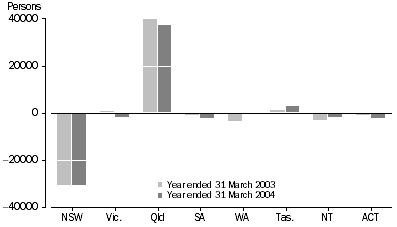
SPECIAL ARTICLE
DIVORCE IN AUSTRALIA
The following article and tables 20 and 21 of this publication are the Main Features of the new electronic product, Divorces, Australia 2002 (cat. no. 3307.0.55.001). The Main Features, Explanatory Notes and Glossary for Divorces, Australia 2002 are now available from the ABS web site http:\\www.abs.gov.au by going to AusStats, Free Summary Info (Main Features), selecting Vitals (number 33), and then choosing the ABS catalogue number 3307.0.55.001. Detailed divorce tables are available for purchase in a data cube, with information about this data cube also accessible through the Main Features web page.
DIVORCES GRANTED
There were 54,000 divorces granted in Australia in 2002, representing a decrease of 2% (or 1,300 divorces) compared with divorces granted in 2001 (55,300). Divorces granted in 2002 were the second highest number granted in the last 20 years, with divorces granted in 2001 being the highest. Divorces in 2002 represent an increase of 18% on the number granted 10 years ago.
Divorces granted
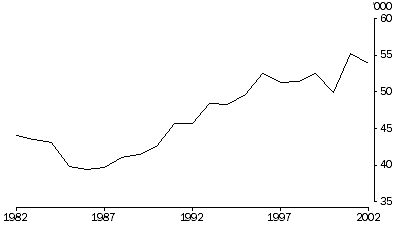
INTRODUCTION OF THE FEDERAL MAGISTRATES COURT
The Family Court of Australia has administered divorce under the Family Law Act 1975 since 1976. In September 2000, the Federal Magistrates Court of Australia (formally known as the Federal Magistrates Service) was established to provide a simpler and more accessible service for litigants and to ease the workload of both the Family Court of Australia and the Federal Court of Australia. The introduction of the Federal Magistrates Court may have had some influence on the decrease in divorces in 2000 and increase in divorces from 2001 onwards (see the Explanatory Notes of Divorces, Australia 2002 for more details).
DIVORCE RATES
The crude divorce rate (the number of divorces per 1,000 population) in 2002 was 2.7 per 1,000. This was a decrease on the 2001 rate of 2.9 per 1,000, a slight increase on the rate 10 years ago (2.6 per 1,000).
As the estimated resident population of Australia by marital status for post 2001 years is not yet available, the latest divorce rates based on the married population are for 2001 (see the Explanatory Notes of Divorces, Australia 2002 for more detail). The divorce rate of the married population in 2001 was 13.1 per 1,000 married men or women. This represents an increase from the rate of 11.9 per 1,000 married men and 12.0 per 1,000 married women in 2000 and an increase from the rate of 11.6 per 1,000 married men and 11.5 per 1,000 married women in 1991.
LIKELIHOOD TO DIVORCE
Analysis of a net nuptiality table indicates that the expectation to divorce is increasing. If a newly-born group of babies was exposed to 1997-1999 rates of marriage, widowing, divorce, remarriage and mortality, 32% of their marriages would end in divorce. This is an increase on the proportion expected if 1990-1992 rates were applied (29%) and if 1985-1987 rates were applied (28%). For further information, see the Special Article 'Lifetime Marriage Formation and Marriage Dissolution in Australia' p.84 of Marriages and Divorces, Australia, 2000 (cat. no. 3310.0).
AGE AT DIVORCE
The median age at divorce (the age at which there are as many people divorcing above the age as there are below it) continued to increase in 2002. The median age of men at divorce was 42.2 years, up from 41.8 years in 2001 and 38.7 years in 1992. For women, the median age increased to 39.5 years, up from 39.1 years in 2001 and 35.9 years in 1992. The rise in the median age at divorce is associated with increasing age at first marriage and to some extent the increase in the interval between marriage and divorce. The median age for males at first marriage in 2002 was 29.0 years, up from 28.7 years in 2001 and 26.9 years in 1992. For females, the median age at first marriage in 2002 was 27.1 years, up from 26.9 years in 2001 and 24.7 years in 1992. More information about marriage statistics can be found in Marriages and Divorces, Australia 2002 (cat. no. 3310.0). The increasing interval between marriage and divorce is discussed in the 'duration of marriage to divorce' section of this commentary.
Median age at divorce
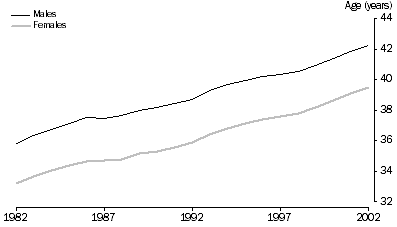
RELATIVE AGE OF DIVORCING PARTIES
In 2002, 10% of divorcing couples were of the same age, 68% involved a younger wife and 19% involved a younger husband. Of all divorcing couples, 33% were aged 1-2 years apart, a further 22% were aged 3-4 years apart, and 23% 5-9 years apart. Couples with an age difference of 10 years or more accounted for 10% of divorcing couples. Of these, 9% of couples involved a wife who was 10 or more years younger to her husband.
AGE-SPECIFIC DIVORCE RATES
Males aged 40-44 years experienced the highest divorce rate in 2002 (13.2 per 1,000). In 1992 and 2001, males aged 35-39 years experienced the highest divorce rate (13.1 per 1,000 and 13.6 per 1,000 respectively). Females aged 30-34 years experienced the highest divorce rate in 2002 (13.7 per 1,000), 2001 (14.4 per 1,000) and 1992 (13.3 per 1,000).
DURATION OF MARRIAGE FOR DIVORCING COUPLES
The median duration of marriage to both separation and divorce is increasing over time, revealing that marriages are, on average, lasting longer. The median duration of marriage to separation in 2002 was 8.6 years, up from 8.3 years in 2001 and 7.4 years in 1992. The median duration of marriage to divorce in 2002 was 12.0 years, up from 11.8 years in 2001 and 10.5 years in 1992.
In 2002, 6% of divorces involved separation within the first year of marriage, 33% within the first five years and a further 22% were separated within five to nine years of marriage. Of the divorcing couples in 2002, 16% were married less than five years, 25% were married between five and nine years and 58% were married for 10 years or more. Around 15% of divorces occurred to couples who had been married for 25 years or more.
Median duration to separation and divorce
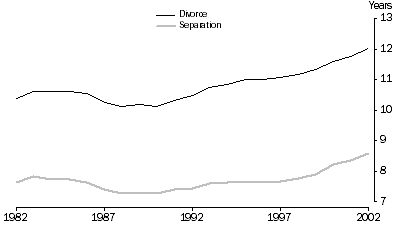
APPLICANT FOR DIVORCE
As in previous years, more women (45%) than men (30%) lodged applications for divorce in 2002. The remainder of divorces granted in 2002 (26%) were the result of joint applications.
The median duration of marriage to divorce was shorter for female and joint applicants (each 11.4 years) than for male applicants (13.8 years).
DIVORCES INVOLVING DEPENDANT CHILDREN
Over the last 10 years, the proportion of divorces involving children under 18 years has fallen slightly from 53% in 1992 to 51% in 2001 and 50% in 2002. The actual number of children involved in divorce in 2002 (50,500) was down 5% compared with 2001 (53,400) and up 10% compared with 1992 (45,800).
Of divorces involving children in 2002, 36% were those where the age of the youngest child was between five and nine years and for 62% of the divorces that involved children, the age of the youngest child was under 10 years.
COUNTRY OF BIRTH OF DIVORCING PARTIES
Country of birth of divorcing parties is not available for 2002. In 2001, 58% of divorces granted were to couples who were both born in Australia. Divorces to couples born in the same overseas country comprised 13% of divorces granted in 2001, while 29% of divorces were granted to couples who had chosen partners from a different country. Of those couples who had chosen a partner from a different country, 42% were overseas-born men divorcing Australian-born women, and 34% were overseas-born women divorcing Australian-born men.
 Print Page
Print Page
 Print All
Print All